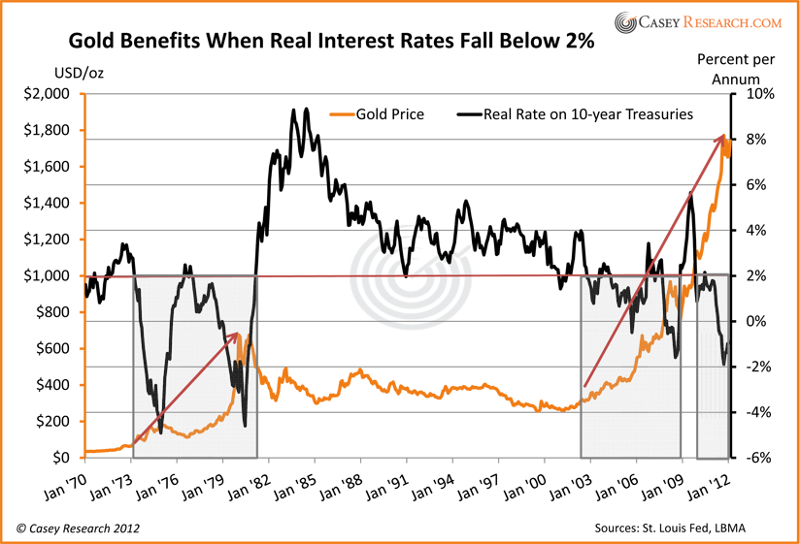Priced for Collapse
By Peter Schiff
Where is the gold price today? If you’re like many Americans, you have no idea whether it went up, down, or sideways. Fortunately, I know my readers to be more informed – you likely know that after falling from almost $1900, gold has been trapped around $1600 since early May. But you may still be curious why despite continued money-printing and abysmal US economic reports, gold hasn’t been able to hit new highs.
Here’s the truth: gold is currently priced for collapse. Many investors believe the yellow metal has topped out and are selling into every rally.
Nerves of Tin
Being a gold investor is tough business. The last thing any government or corrupt big bank wants is to have a bunch of people putting their savings into hard assets – and gold is one of the hardest of all. So we’re constantly up against tides of propaganda saying that gold has no value or is the refuge of doomsayers.
The effect of this is that even heavy gold investors are always waiting for the other shoe to drop. When house prices were rising, no one was worried that the market had peaked or prices were unsustainable. No one was asking whether all the thin-walled McMansions going up would actually be worth anything in a generation. But for gold, Wall Street has been shorting it all the way up!
Nowhere is this pessimism more evident that in gold mining stocks. Rising inflation has driven production costs higher, but the mistaken belief that inflation is contained and Treasuries are a safer haven is keeping a lid on gold prices. As such, many of the major producers have missed their earnings projections, and their share prices have been punished. This has placed a cloud over the entire sector. In fact, the P/E ratios of major gold miners are near record lows. Stock prices reflect future earning expectations, and judging by the low P/Es, Wall Street expects future earnings to plummet. This likely reflects their bearish outlook for gold, which is generally viewed as a bubble about to pop.
Chronic Memory Loss
Unfortunately, there is no public validation for those who have proved the gold doubters wrong. A couple of years ago, I predicted gold would cross $1500 and even my own staff thought the call was too risky, too extreme. But I knew then, as I know now, that at the end of the day the gold price is not a mystery – it’s a proxy for dollar weakness.
Since most investors do not truly understand gold’s economic role, they assume the 10-year bull market must be a mania. But manias show parabolic growth detached from any fundamental driver. The definition of a mania is the bidding up of an asset quickly and beyond all long-term justification.
Gold, however, has grown steadily in inverse correlation with real interest rates, as explained by Jeff Clark and Mark Motive in past issues of this newsletter. As a reminder, here’s a chart detailing the correlation:
(Click to enlarge)
The Opportunity of the Decade
After spending the previous fall and winter testing new nominal highs above $1800, future investors may come to view spring and summer 2012 as the opportunity of the decade. Gold has shown its strength and retreated. While most investors will take that as a signal that the market has topped, some will take advantage of the general trepidation to add to their positions at hundreds of dollars off the highs.
While I think gold is a bargain at $1900 considering today’s circumstances, the market phobia of a price collapse is allowing us to buy at well under established highs. It’s as if you already wanted to go swimming, but you found out when you got there that the pool was heated.
What Happens Next
I’ve seen markets like this before, and by making some reasonable inferences, I have a good picture of how this could play out. Gold will continue testing the $1600 barrier until it surprises to the upside. This could be spurred by the announcement of QE III, a calming of fears in Europe, or any shock to the Treasury market. Treasuries have temporarily overtaken gold as the primary safe-haven asset. Once that dynamic is broken, I believe the counterflow into gold will be tremendous.
Right now, there is a haze over investors. Frightful news from Europe and a slowdown in Asia have shaken confidence in any asset that doesn’t have the steady track record of US debt. But as I often remind my clients, past performance doesn’t guarantee future results. Any news that wakes investors up to the coming collapse of the Treasury market will likely trigger a rush into the one asset with a track record as long as civilization itself.
Prepare for Collapse
The key to this market is to understand that a price collapse is coming – but not for gold. Instead, the market for US dollars and dollar-denominated debt is headed off a cliff, which will send the price of precious metals soaring.
Now is a time for uncommon confidence. Everyone knows Treasuries to be safe, just as they knew house prices would always rise. Then as now, gold’s value and utility are doubted. But my readers know better.
Follow us on Twitter to stay up-to-date on Peter Schiff’s latest thoughts: @SchiffGold
Interested in learning about the best ways to buy gold and silver?
Call 1-888-GOLD-160 and speak with a Precious Metals Specialist today!




 In 2009, 140 banks failed, and a recent report from financial consulting firm Klaros Group says that hundreds of banks are at risk of going under this year. It’s being billed mostly as a danger for individuals and communities than for the broader economy, but for stressed lenders across America, a string of small bank failures could quite […]
In 2009, 140 banks failed, and a recent report from financial consulting firm Klaros Group says that hundreds of banks are at risk of going under this year. It’s being billed mostly as a danger for individuals and communities than for the broader economy, but for stressed lenders across America, a string of small bank failures could quite […] Cocoa prices have dumped since rocketing to a dramatic peak last month as an El Nino cycle winds down and traders rush out of the illiquid market. For now, depreciating fiat currencies are still keeping the cocoa price still far above its 2023 levels. Coffee has had a similar rise and subsequent correction — but now, inflation and other factors are conspiring to […]
Cocoa prices have dumped since rocketing to a dramatic peak last month as an El Nino cycle winds down and traders rush out of the illiquid market. For now, depreciating fiat currencies are still keeping the cocoa price still far above its 2023 levels. Coffee has had a similar rise and subsequent correction — but now, inflation and other factors are conspiring to […] California’s government bet that they knew better than the free market. And now millions are paying the price. The story begins in 1919, when the city of Berkley, California instituted legislation setting aside districts that would only allow the construction of single-family housing. The idea spread, and soon much of California’s urban areas had adopted the zoning policy. Today, approximately 40% of the total land in Los Angeles is […]
California’s government bet that they knew better than the free market. And now millions are paying the price. The story begins in 1919, when the city of Berkley, California instituted legislation setting aside districts that would only allow the construction of single-family housing. The idea spread, and soon much of California’s urban areas had adopted the zoning policy. Today, approximately 40% of the total land in Los Angeles is […] The yen was once known as a safe-haven currency for investors to protect themselves when broader markets are shaky or other currencies are dropping, but those days are numbered. A stable government and consistent (and low) interest rates have been some of the driving factors, but it’s the unwinding of that ultra-low interest rate policy that will be the yen’s “safe […]
The yen was once known as a safe-haven currency for investors to protect themselves when broader markets are shaky or other currencies are dropping, but those days are numbered. A stable government and consistent (and low) interest rates have been some of the driving factors, but it’s the unwinding of that ultra-low interest rate policy that will be the yen’s “safe […] Whenever an election year rolls around, domestic manufacturing becomes a more central theme of discussion. Candidates from both sides, who seem to disagree on almost everything else, never waver in their commitment to auto manufacturers in Detroit and the steel industry. Republicans and Democrats never forget to remind the American public that they will try […]
Whenever an election year rolls around, domestic manufacturing becomes a more central theme of discussion. Candidates from both sides, who seem to disagree on almost everything else, never waver in their commitment to auto manufacturers in Detroit and the steel industry. Republicans and Democrats never forget to remind the American public that they will try […]
Leave a Reply